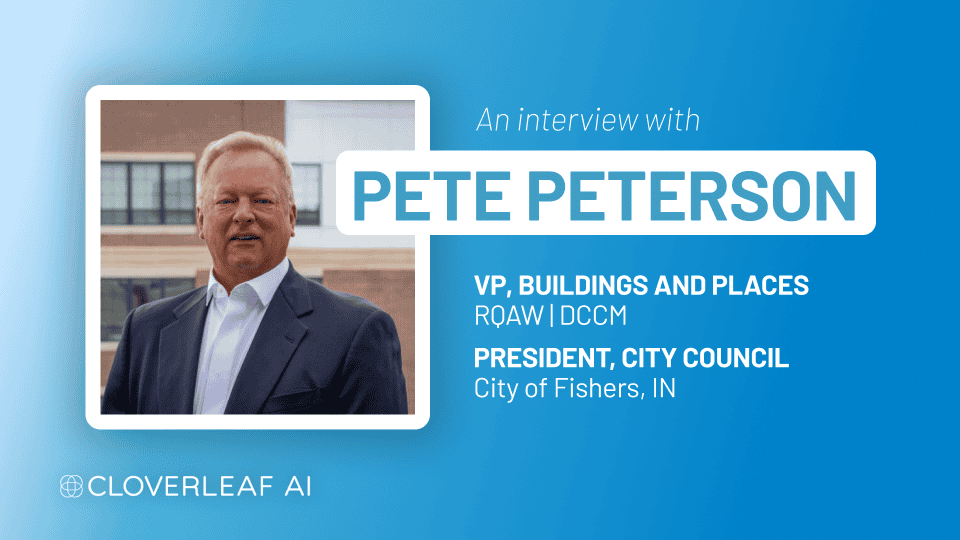When it comes to state and local government contracting, relationships, timing, and intelligence make all the difference. Pete Peterson, Vice President of the Buildings and Places Division at RQAW | DCCM, brings a rare dual perspective to public-sector development. In addition to his leadership role at RQAW, he serves as a city council member in Fishers, Indiana (population 104,094), giving him firsthand insight into how municipalities prioritize and fund projects—and how vendors can better align with those needs.
Pete’s experience is representative of the buyer persona many vendors are trying to reach: someone who not only influences city budgets but also understands how projects evolve behind the scenes. His approach to business development offers a blueprint for firms looking to succeed in the competitive world of local government contracts.
Understanding the Real Decision-Makers in Local Government Contracts
According to Pete, winning municipal work starts with understanding who’s actually shaping the decisions. “A lot of people think, ‘If I go talk to the mayor or the council president, I’ve done my job,’” he says. “That’s not always the case. It’s often the staff, the people giving the reports back to the governing bodies, who are really shaping the project direction.”
With a city the size of Fishers, there are multiple layers of influence. Pete emphasizes the importance of “spreading yourself around the account,” building relationships across departments, understanding each leader’s priorities, and keeping tabs on how their agendas shift.
Discover Contracting Opportunities Before the RFP Is Published
RQAW | DCCM focuses on infrastructure, public safety, and economic development—all high priorities for growing cities. But as Pete notes, by the time an RFP is published, it’s often too late to engage meaningfully.
“You need to understand what that department head wants for their community. If you don’t know what’s on their radar before the public meeting happens, you’re already behind.”
Many vendors wait for the RFP to engage, but by then, the scope may already be shaped by competitors who were in the room early. Pete’s strategy is to spot signals months in advance by paying close attention to city council discussions, planning meetings, and department-level conversations. That kind of foresight allows his team to proactively align with city priorities and tailor solutions that resonate—long before the procurement process formally begins.
Cloverleaf helps surface these early signals at scale, enabling Pete’s team to anticipate opportunities instead of reacting to them.
Save Time by Monitoring City Council Meetings with Technology
With team members covering regions across the state, Pete’s team can’t physically attend every city council or planning commission meeting. “They cannot make every meeting. They cannot be in front of every department head or decision-maker,” Pete explains.
Cloverleaf solves that by automatically analyzing public meetings and surfacing relevant projects. This allows his team to monitor dozens of municipalities at once and zero in on the conversations that matter most.
“It gives me the intel I need—fast. Then I can deploy my team to that account and get in front of the right people, at the right time. It’s an invaluable resource.”
Beyond efficiency, this gives Pete’s team a strategic edge. While competitors may be chasing posted opportunities, his team is already in discussions with stakeholders, shaping project scope, and building trust.
Understand Local Government Budgets and Capital Project Priorities
Pete also offered insights into how cities like Fishers allocate their budgets: while a large portion goes to payroll and insurance, infrastructure and capital projects still represent significant spending.
“Think 30–40% of the city budget is going to infrastructure. Economic development may take a hit, but we make up for that through things like TIF revenue,” he explains.
Understanding how different municipalities prioritize funding gives business developers like Pete a competitive edge, especially when those insights are paired with Cloverleaf’s early-warning system for upcoming projects.
This understanding isn’t just helpful, it’s crucial. Knowing how a city funds a project can shape how you pitch your services, structure your pricing, or identify the right financing mechanisms to support your solution.
Tips for Vendors Competing for State and Local Government Contracts
Pete’s advice to other vendors looking to win in the public sector? “Put in the legwork. Spend time understanding the vision of each department head. Get to the meetings or use a product like Cloverleaf to help you do it.”
And though he describes himself as a “tail-end Baby Boomer,” Pete isn’t afraid to lean on technology. “I may not understand all of it, but I know it’s not going away. I believe Cloverleaf is going to pay off.”
This mindset, open to innovation but grounded in experience, is what sets successful public sector business development teams apart. It’s not about replacing relationships with software, but about using the right tools to scale and sharpen those relationships.
Why Early Intelligence Is the Key to Winning Local Government Work
The future of public sector business development is changing. Vendors that win at the local level will be those who gain insight earlier, build relationships smarter, and move faster. Cloverleaf helps make that possible—and Pete Peterson’s team is living proof.
Want to see what Cloverleaf can do for your business development team? Schedule a demo today.
–







